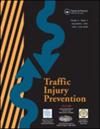Motorcycle riders and pillion passengers injury patterns and in-hospital outcomes based on the National Trauma Registry of Iran
IF 1.9
3区 工程技术
Q3 PUBLIC, ENVIRONMENTAL & OCCUPATIONAL HEALTH
引用次数: 0
Abstract
Objective
Road traffic injury (RTI) is the second leading cause of death and disability, and motorcycle crashes rank as the first cause of traffic fatality in Iran. We aimed to compare various characteristics between traumatized motorcycle riders and pillion passengers registered with the National Trauma Registry of Iran (NTRI).
Methods
This is a retrospective study of the NTRI, an ongoing multicenter trauma database built on a registry. This study included injured motorcyclists from six major trauma centers nationwide admitted between February 2017 and November 2023. Motorcyclists should have been hospitalized for RTIs and met the NTRI’s inclusion criteria. We assessed patients regarding their demographics, clinical features, the pattern of injuries, and diverse in-hospital outcomes.
Results
Of 54,342 registered patients in the NTRI, 7,594 motorcyclists were included. Of them, 6,636 (87.4%) were riders, and 958 (12.6%) were pillion passengers. Among all, 7165 (94.5%) were male, and 420 (5.5%) female (p < 0.001). Only 656 (9.9%) of riders and 24 (2.5%) of pillion passengers were wearing helmets (p < 0.001). Lone motorcyclist crashes led to injuries in 1,394 (21.2%) riders and 332 (35.5%) pillion passengers (p < 0.001). Glasgow Coma Scale (GCS) was 3 to 8 in 204 (3.1%) riders and 16 (1.7%) pillion passengers (p = 0.016). The most frequent pattern of poly-trauma was “head and thorax,” with 43 (32.3%) riders and 5 (25.0%) pillion passengers (p = 0.362). Univariable logistic regression analysis showed that Intensive Care Unit (ICU) admission (OR = 0.78, CI 95% = 0.62 to 0.97, p = 0.028) and mechanical ventilation (OR = 0.58, CI 95% = 0.39 to 0.84, p = 0.004) were significantly lower in pillion passengers compared to motorcycle riders. After adjustment for age, gender, occupational status, and helmet use, being a rider or a pillion passenger didn’t have a significant association with any of the in-hospital outcomes.
Conclusions
Motorcycle riders and pillion passengers sustain the same injuries in terms of pattern, severity, and in-hospital outcomes. Therefore, healthcare providers can approach them similarly. Since there is a high number of underage riders and helmets are not used commonly, there should be more police enforcement in this case.
基于伊朗国家创伤登记处的摩托车驾驶员和乘客受伤模式及住院治疗结果。
目的:道路交通伤害(RTI)是导致死亡和残疾的第二大原因,而在伊朗,摩托车碰撞事故是导致交通事故死亡的第一大原因。我们的目的是比较在伊朗国家创伤登记处(NTRI)登记的受创伤摩托车驾驶员和乘客的各种特征:这是一项对伊朗国家创伤登记处(NTRI)的回顾性研究,NTRI 是一个建立在登记处基础上的持续性多中心创伤数据库。这项研究包括 2017 年 2 月至 2023 年 11 月期间全国六大创伤中心收治的受伤摩托车手。摩托车手应因 RTI 住院,并符合 NTRI 的纳入标准。我们对患者的人口统计学、临床特征、受伤模式以及不同的院内结局进行了评估:在 NTRI 登记的 54,342 名患者中,有 7,594 名摩托车手被纳入其中。其中,6636 人(87.4%)为骑手,958 人(12.6%)为乘客。其中 7 165 人(94.5%)为男性,420 人(5.5%)为女性(p p p = 0.016)。最常见的多发性创伤模式是 "头部和胸部",其中有 43 名骑手(32.3%)和 5 名乘客(25.0%)(P = 0.362)。单变量逻辑回归分析显示,与摩托车骑手相比,摩托车乘客入住重症监护室(ICU)(OR = 0.78,CI 95% = 0.62 至 0.97,p = 0.028)和机械通气(OR = 0.58,CI 95% = 0.39 至 0.84,p = 0.004)的比例明显较低。在对年龄、性别、职业状况和头盔使用情况进行调整后,摩托车骑手或乘客与任何院内结果都没有明显关联:结论:摩托车骑手和乘客的受伤模式、严重程度和住院结果都是一样的。因此,医疗服务提供者可以采取类似的方法。由于未成年骑手人数众多且头盔使用并不普遍,警方应加大执法力度。
本文章由计算机程序翻译,如有差异,请以英文原文为准。
求助全文
约1分钟内获得全文
求助全文
来源期刊

Traffic Injury Prevention
PUBLIC, ENVIRONMENTAL & OCCUPATIONAL HEALTH-
CiteScore
3.60
自引率
10.00%
发文量
137
审稿时长
3 months
期刊介绍:
The purpose of Traffic Injury Prevention is to bridge the disciplines of medicine, engineering, public health and traffic safety in order to foster the science of traffic injury prevention. The archival journal focuses on research, interventions and evaluations within the areas of traffic safety, crash causation, injury prevention and treatment.
General topics within the journal''s scope are driver behavior, road infrastructure, emerging crash avoidance technologies, crash and injury epidemiology, alcohol and drugs, impact injury biomechanics, vehicle crashworthiness, occupant restraints, pedestrian safety, evaluation of interventions, economic consequences and emergency and clinical care with specific application to traffic injury prevention. The journal includes full length papers, review articles, case studies, brief technical notes and commentaries.
 求助内容:
求助内容: 应助结果提醒方式:
应助结果提醒方式:


